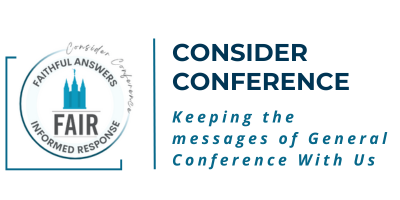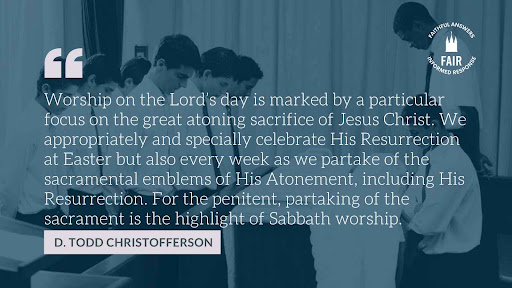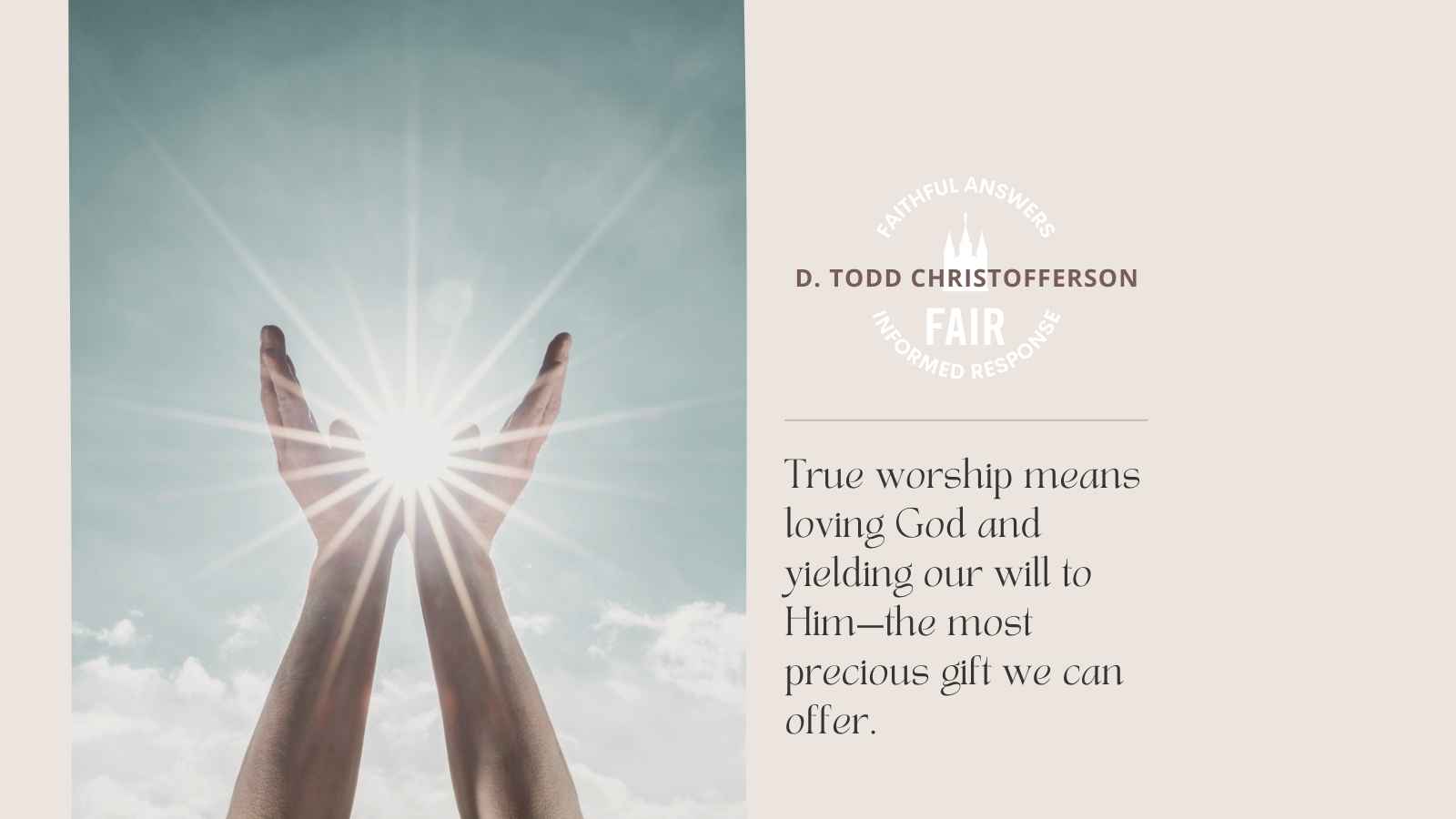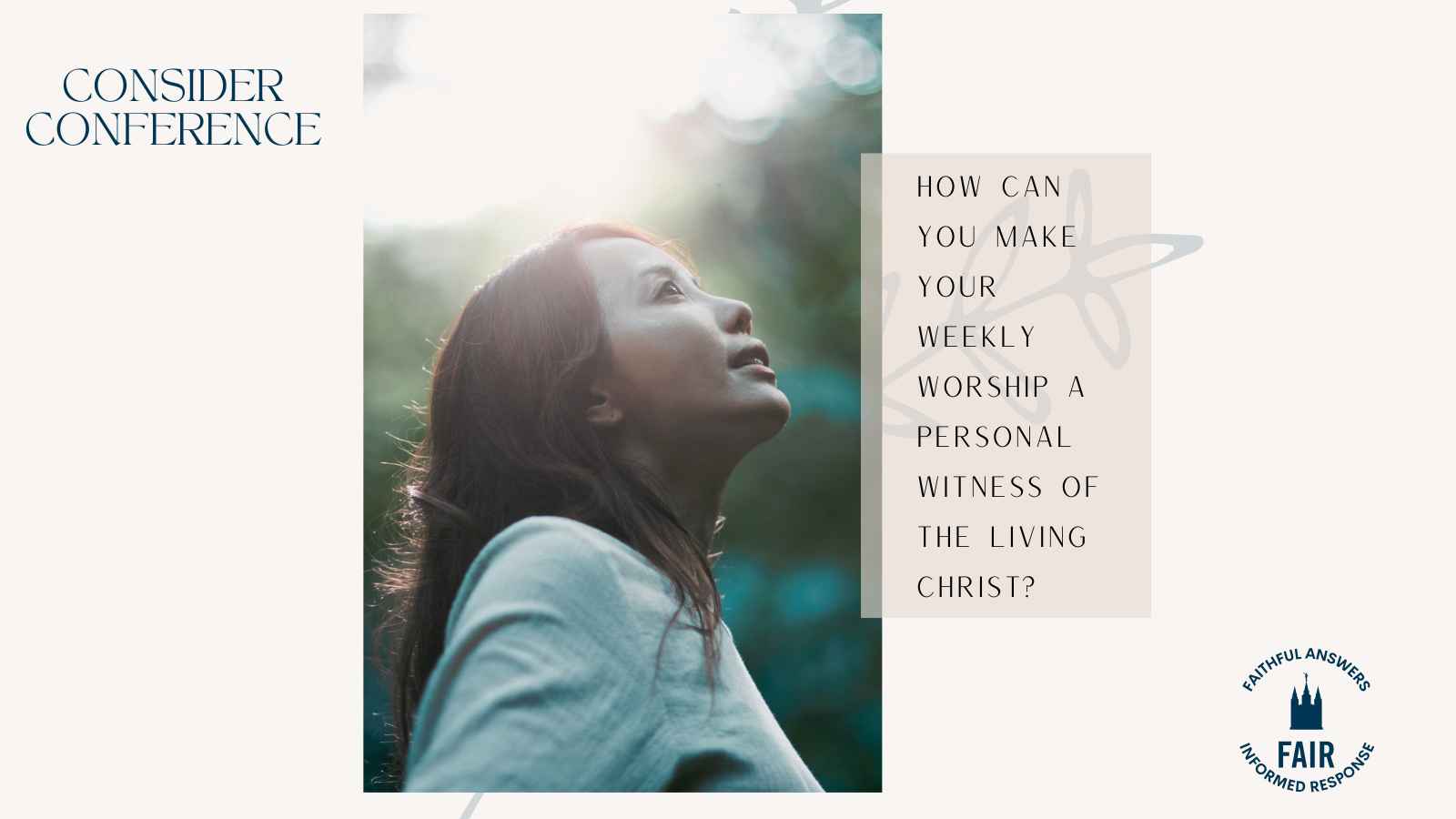Did you know that FAIR has Easter Resources? Find them here.

Carrying the Message of Easter into Every Sabbath
What does it mean to truly worship—not just attend, sing, or pray, but offer your whole soul?
In his stirring General Conference address, “Worship”, Elder D. Todd Christofferson invites us to reexamine how we honor God. He outlines four sacred dimensions of worship: our actions, attitudes, loyalties, and our emulation of the Father and the Son.
Elder Christofferson makes clear that worship is not a passive experience—it is an intentional offering that transforms us, helps us overcome enmity, and unites us with God and one another. As we study Doctrine and Covenants 37–40, which calls early Saints to forsake comfort and pursue “the riches of eternity” (D&C 38:39), this message becomes especially poignant.
And as this Easter Sunday reminds us, every time we partake of the sacrament, we celebrate both the Atonement and Resurrection of Jesus Christ. Worship is our witness that He lives—and that His power lives in us.

 Apologetic Issues: Worship and Eternal Priorities
Apologetic Issues: Worship and Eternal Priorities
Criticism: Worship is private and personal—communal gatherings are outdated or unnecessary.
Response: Elder Christofferson teaches that “worshipping together as ‘the body of Christ’” strengthens us and unites us in shared covenants (see 1 Corinthians 12:12–27). Private devotion matters, but communal worship builds Zion—it’s how we practice unity and become one (see D&C 38:27).
 Cognitive Bias: Availability Heuristic
Cognitive Bias: Availability Heuristic
This bias leads people to judge the truth of an idea based on how easily examples come to mind. If someone has seen insincere worship—like a hypocritical person at church or a boring service—they may overgeneralize, assuming all worship is hollow. Their brain defaults to what’s memorable, not what’s representative. They forget the many quiet, sincere acts of devotion they may not have witnessed.
Solution: Help reframe the discussion by offering personal, heartfelt examples of worship that shaped your character, healed your soul, or unified your family or ward. Invite others to reflect on their own experiences rather than relying on cynical stereotypes or isolated bad examples.
Criticism: Prioritizing eternal rewards over material success is naïve and impractical.
Response:
The riches of eternity (D&C 38:39) offer something the world cannot: lasting peace, joy, and spiritual power. Elder Christofferson affirms that those who worship the Father and the Son are transformed through covenant living—not just in the life to come, but now. He warns that whatever takes precedence over worship becomes a false god, leading us away from our divine identity and unity with others. Worship reveals what we truly treasure.
Common Fallacy: Appeal to Materialism – This fallacy assumes only tangible, worldly gain has value. Modern culture often portrays those who forsake worldly wealth for religious devotion as out of touch or irresponsible.
Solution: Valuing eternal truths over worldly gain is not irrational—it reflects a long-term perspective grounded in faith and eternal purpose. As seen in Doctrine and Covenants 40, James Covel lost his promised blessings by choosing “the cares of the world.” Elder Christofferson helps us reframe worship as the clearest expression of what we truly value.

 Apologetic Application: The Atonement of Jesus Christ
Apologetic Application: The Atonement of Jesus Christ
 Core Doctrine: The Atonement of Jesus Christ is the foundation of worship. Through His infinite sacrifice and literal Resurrection, we are redeemed and sanctified (see 3 Nephi 9:20; D&C 20:19).
Core Doctrine: The Atonement of Jesus Christ is the foundation of worship. Through His infinite sacrifice and literal Resurrection, we are redeemed and sanctified (see 3 Nephi 9:20; D&C 20:19).
Defending Core Beliefs
1⃣ Misconception: Worship is only symbolic.
 Clarification: Elder Christofferson shows that true worship transforms us as we emulate Christ. It is covenantal and sanctifying—not passive or performative.
Clarification: Elder Christofferson shows that true worship transforms us as we emulate Christ. It is covenantal and sanctifying—not passive or performative.
2⃣ Follow-up Misconception: The sacrament is just a weekly tradition.
 Clarification: Each time we partake, we renew our covenants and receive strength from Christ’s living power. It’s not just remembrance—it’s renewal. (See D&C 20:77–79)
Clarification: Each time we partake, we renew our covenants and receive strength from Christ’s living power. It’s not just remembrance—it’s renewal. (See D&C 20:77–79)
 Real-Life Analogy: Worship is like plugging into a power source. Without that connection, we cannot access the spiritual strength Christ offers. Sacrament worship is how we stay spiritually charged.
Real-Life Analogy: Worship is like plugging into a power source. Without that connection, we cannot access the spiritual strength Christ offers. Sacrament worship is how we stay spiritually charged.
 Practical Apologetic Use
Practical Apologetic Use
When someone justifies division—whether by race, politics, class, or even offense—Doctrine and Covenants 38:27 reminds us: “If ye are not one ye are not mine.” This isn’t a suggestion—it’s a covenant command. Elder Christofferson’s teaching on worship adds critical clarity: true worship emulates the unity of the Father and the Son. When we sincerely worship, we don’t cling to our differences—we offer them up in humility and love. Apologetically, this principle helps us respond to claims that religion promotes exclusion or division. We can affirm instead that real discipleship dismantles enmity, not excuses it. Christ prayed “that they all may be one” (John 17:21) and commanded His disciples to have “no disputations among you” (3 Nephi 11:30). Unity is not sameness—it’s spiritual oneness rooted in shared covenant, not shared opinions. Worship transforms us into a people who can “love one another” across all human lines.
 Historical and Doctrinal Connections
Historical and Doctrinal Connections
In early 1831, Saints in New York were commanded to leave their homes and gather in Ohio—a place they had never seen. The Lord promised “great things” ahead (see D&C 39:8), but only if they forsook the “cares of the world” (D&C 40:2).
This mirrors Elder Christofferson’s insight that worship requires sacrifice. When we truly worship, we leave behind worldly distractions and draw closer to the living Christ.
 Doctrinal Link:
Doctrinal Link:
“If ye are not one ye are not mine” (D&C 38:27).
Worship unifies us, sanctifies us, and helps us build Zion.
 Living Apologetics: Worship as Witness
Living Apologetics: Worship as Witness
 Principle: How can we help others understand that worship isn’t just performance, but power?
Principle: How can we help others understand that worship isn’t just performance, but power?
 Key Principle:
Key Principle:
Worship is both devotion and transformation. Elder Christofferson teaches that worship is not passive—it is a daily, covenant-based commitment to live like Christ. It unifies us, reorients our priorities, and fills us with sanctifying grace.
1⃣ Clarify the purpose of worship – Emphasize that true worship invites transformation. It’s not about appearance or habit but about aligning our will with God’s and receiving His grace.
2⃣ Use worship as a response to criticism – When someone claims religion is hollow or superficial, explain that sincere worship—especially the sacrament—connects us directly to Christ’s Atonement and Resurrection, offering a power the world cannot replicate.
 Practical Application
Practical Application
 Use the Sabbath as a spiritual signal. Ask, as President Nelson once did: “What sign do I want to give to God today?” Choose Sunday practices that reflect reverence, joy, and renewal.
Use the Sabbath as a spiritual signal. Ask, as President Nelson once did: “What sign do I want to give to God today?” Choose Sunday practices that reflect reverence, joy, and renewal.
 Let your worship show in how you treat others. If “how we live may be the best, most genuine form of worship,” then kindness, forgiveness, and generosity are apologetic tools. They testify of a living Christ more powerfully than words alone.
Let your worship show in how you treat others. If “how we live may be the best, most genuine form of worship,” then kindness, forgiveness, and generosity are apologetic tools. They testify of a living Christ more powerfully than words alone.
Faith in Action: Share the Message
 1. Family Conversation: Share what the sacrament means to you and how it renews your relationship with Christ.
1. Family Conversation: Share what the sacrament means to you and how it renews your relationship with Christ.
 2. Teaching Moment: In a Sunday School or youth class, invite others to describe how worship has changed them.
2. Teaching Moment: In a Sunday School or youth class, invite others to describe how worship has changed them.
 3. Online Witness: Post the quote, “To worship is to intentionally praise and adore our God in a way that transforms us,” with a reflection on what Easter means to you personally.
3. Online Witness: Post the quote, “To worship is to intentionally praise and adore our God in a way that transforms us,” with a reflection on what Easter means to you personally.
 Quick Reference: Key Defenses and Facts
Quick Reference: Key Defenses and Facts
 Worship is transformative, not performative – True worship draws us into deeper discipleship and sanctification. (3 Nephi 9:20; John 14:15)
Worship is transformative, not performative – True worship draws us into deeper discipleship and sanctification. (3 Nephi 9:20; John 14:15)
 The sacrament celebrates both the Atonement and the Resurrection – It renews covenants and testifies that Christ lives. (D&C 20:77–79)
The sacrament celebrates both the Atonement and the Resurrection – It renews covenants and testifies that Christ lives. (D&C 20:77–79)
 The riches of eternity outweigh earthly success – Worship reorients us to eternal priorities. (D&C 38:39; 40:2)
The riches of eternity outweigh earthly success – Worship reorients us to eternal priorities. (D&C 38:39; 40:2)
Conclusion: Carrying Easter into Every Sabbath
Elder Christofferson’s message reminds us that worship is the way we show we believe in the Resurrection—not just once a year, but every week. Through sacrament, service, and daily devotion, we offer our hearts and receive Christ’s power.
As we remember the empty tomb, we also remember the table of the Lord—where we sit, week after week, to proclaim: He lives.
 Reflective Question:
Reflective Question:
How can you make your weekly worship a personal witness of the living Christ?

The Consider Conference series by FAIR offers an in-depth look at recent General Conference talks to help members of the Church of Jesus Christ of Latter-day Saints navigate common questions, misunderstandings, and criticisms. Each post provides doctrinal insights, historical context, and practical ways to apply gospel principles in everyday conversations. Through this series, we hope to equip readers with faith-promoting resources that encourage thoughtful reflection, respectful dialogue, and a stronger foundation in gospel truths, fostering both personal conviction and meaningful discussions with others.
The post Worship That Transforms: Becoming One Through Christ appeared first on FAIR.
Continue reading at the original source →



